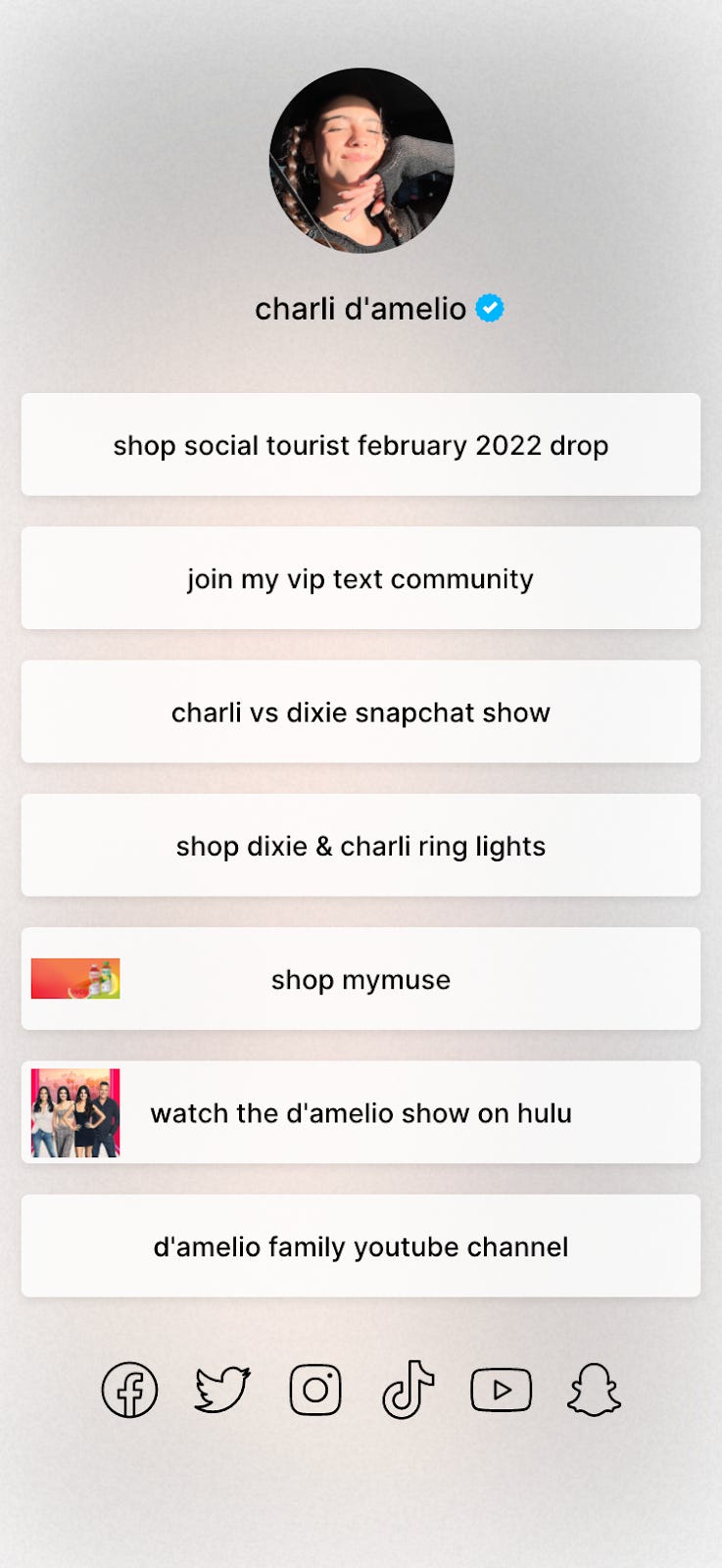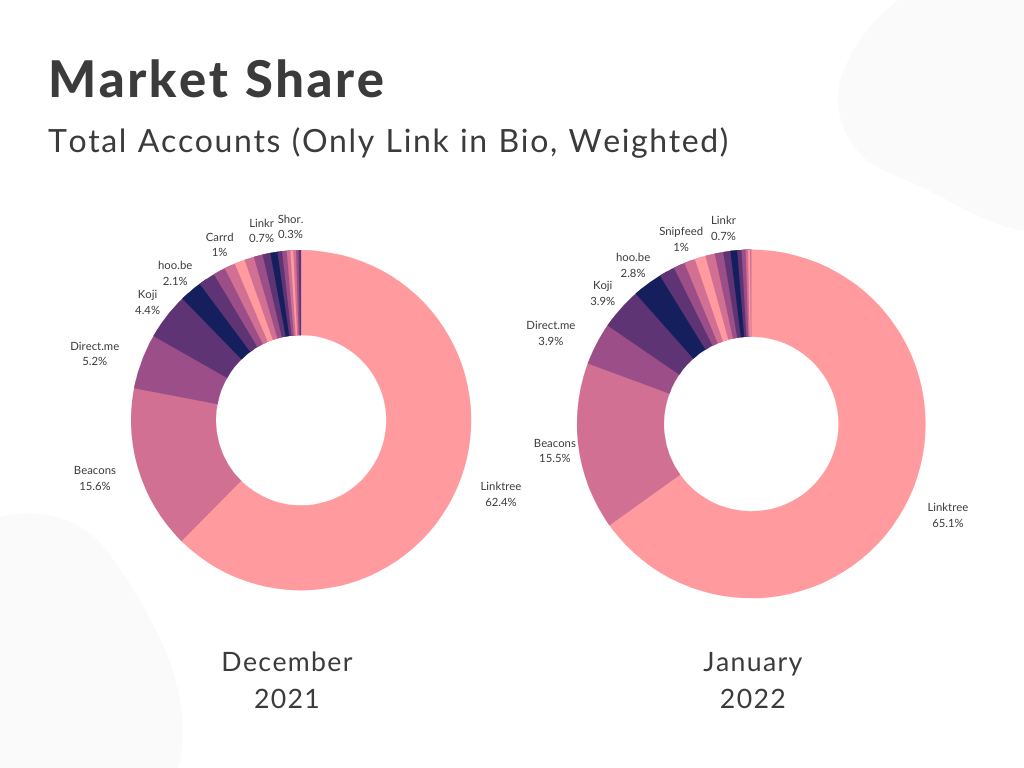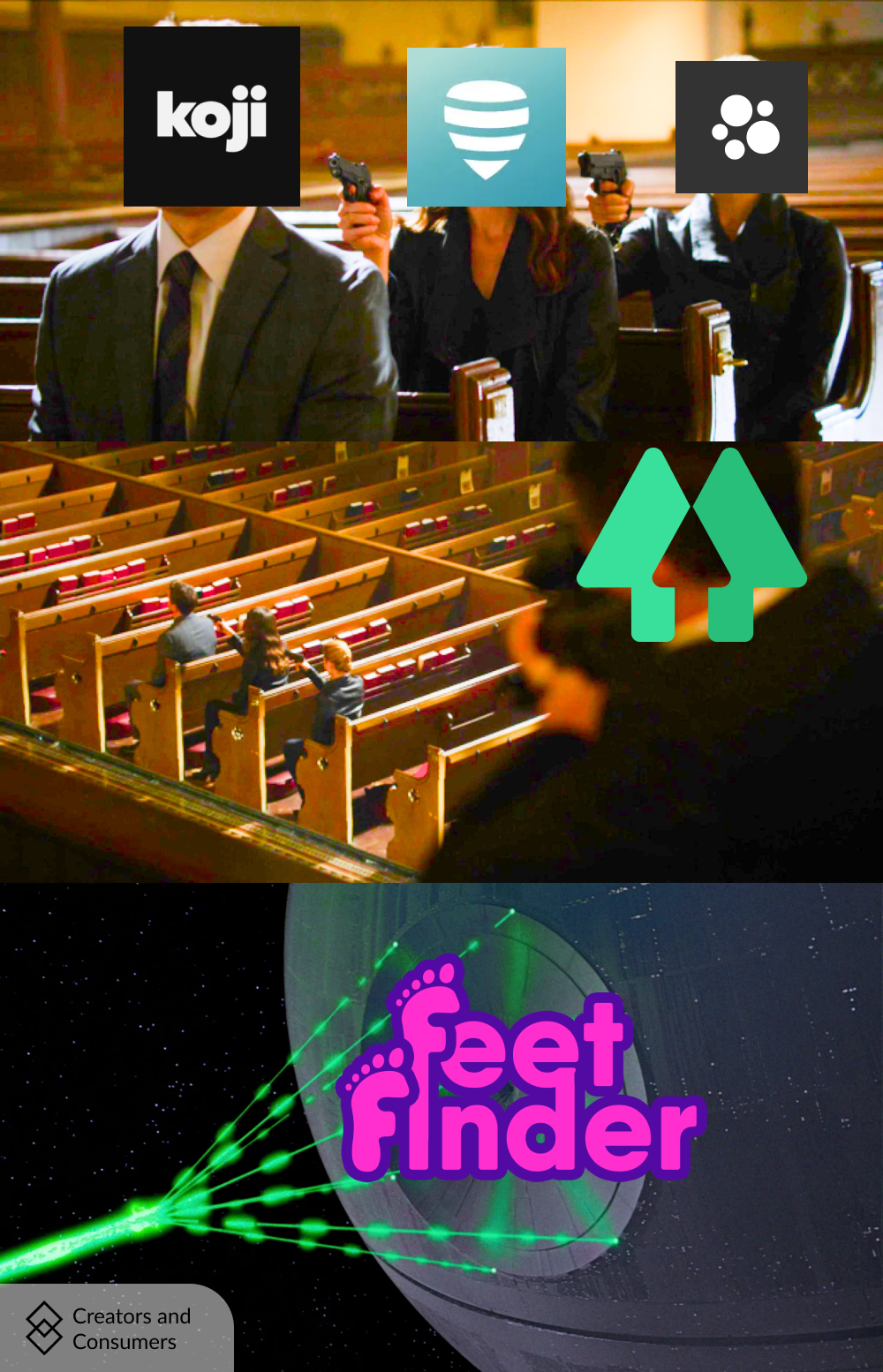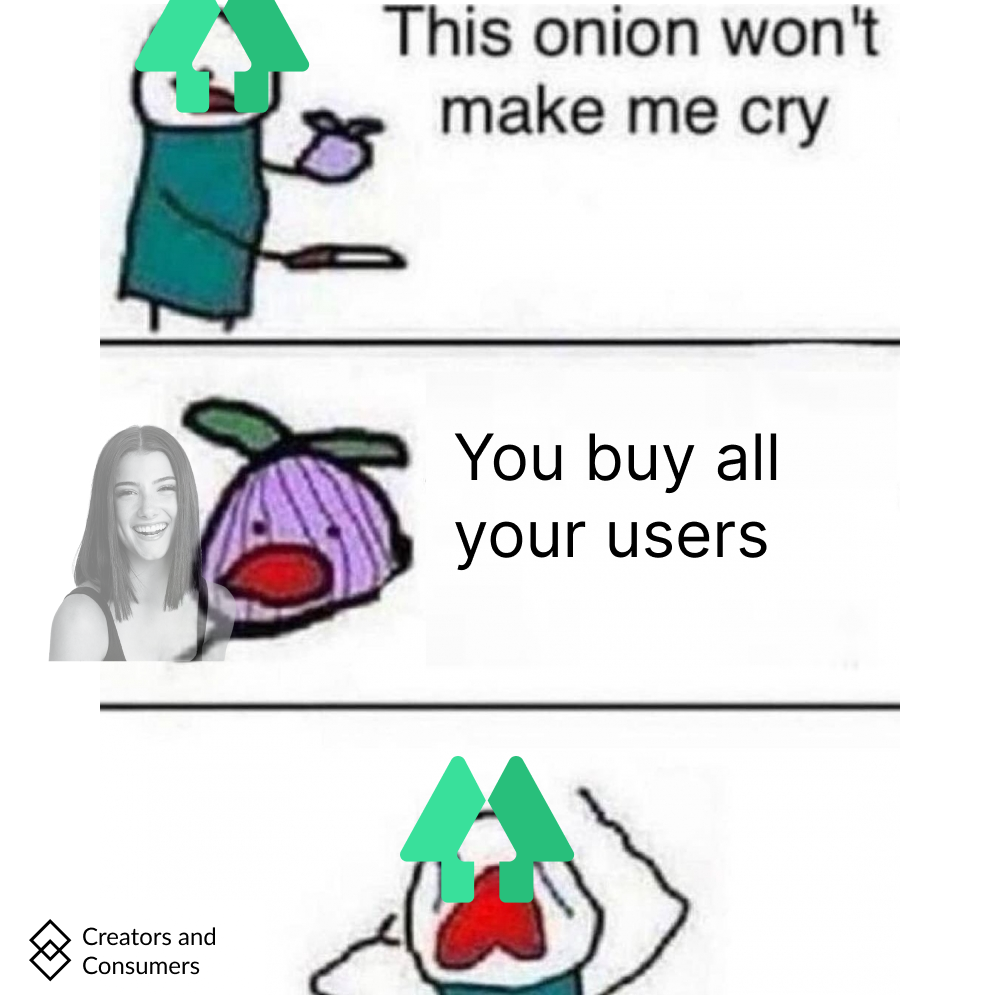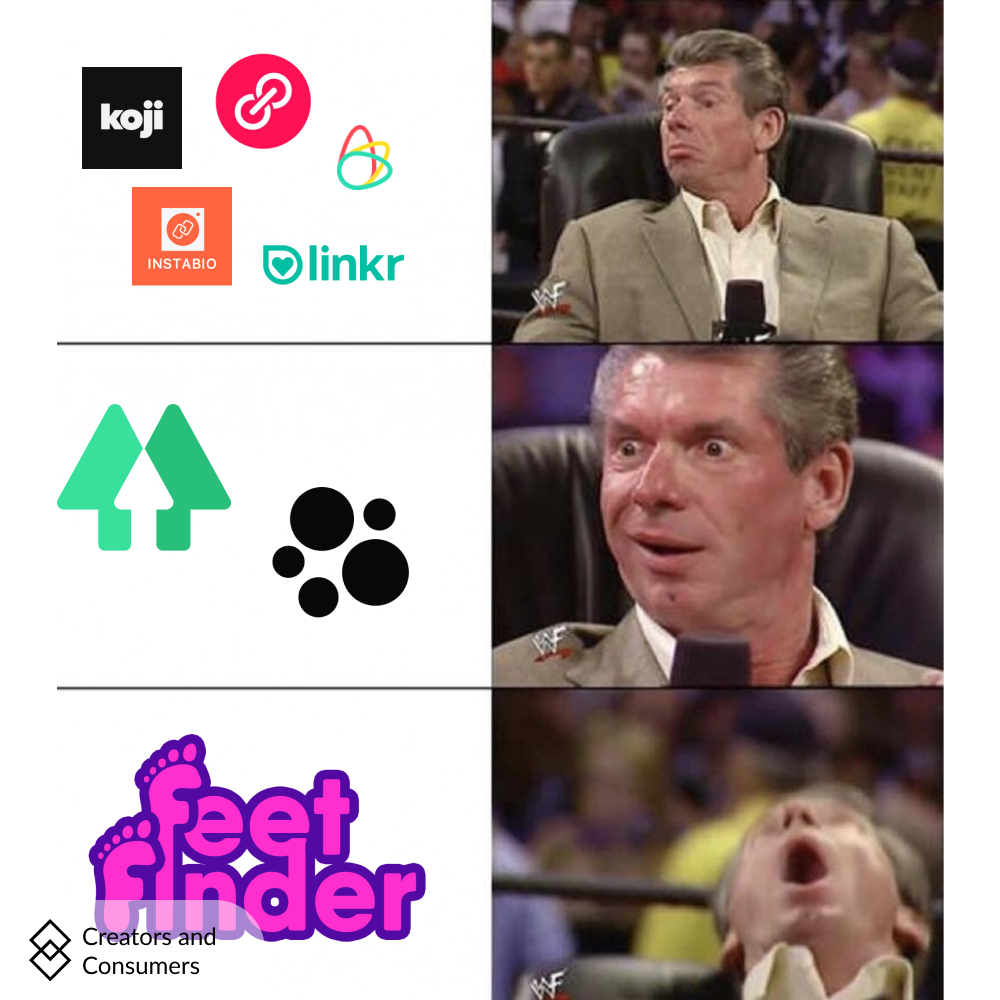Background: The Importance of Link-in-Bio
Link-in-Bio startups allow users to create lightweight web pages displaying links to all of their social media profiles and content. These pages are then linked in users’ TikTok and Instagram bios to get around the one link limit present on those platforms.
It’s a simple problem, but the space has grown quickly and has attracted significant venture investment. The original and most popular Link-in-Bio startup is Linktree, which serves over 24 million users in total and has raised over 165 million USD. The fast-growing newcomer to the space is Beacons, which serves around 1 million users in total. Beacons was started by three Stanford machine learning PhDs (talk about being overqualified) and has raised 6 million from Andreesen Horowitz. Other popular solutions include Koji (36 million raised), Universe (47.3 million raised), and Hoo.be (6 million raised).
Beyond their core functionality, offerings will often include tip jars, paywalled content solutions, and other monetization features, allowing users to monetize their sites. When combined with the massive traffic brought by popular influencers, creators, and celebrities using their product, Link-in-Bio startups are presented with a sizable revenue stream from which they can take a cut. Many Link-in-Bio startups also monetize directly from their users by offering premium, paid subscriptions with more functionality than their free plans. What’s been most attractive to investors and operators, however, has been the strategically valuable real-estate these startups have claimed. Link-in-Bio solutions serve as gateways for other creator-focused startups: other tools helping creators to monetize like Patreon, Cameo, Onlyfans, and Fanhouse often rely on a creator’s Link-in-Bio for traffic. The long-term bet is that Link-in-Bio companies will play a pivotal role in the development of the larger creator economy.
That said, Link-in-Bio solutions are simple to build technically and thus have low barriers to entry. As a result, there are well over 30 different competitors in the space, all offering slightly different takes on the same functionality. But that hasn’t stopped investors from coming in: the space recently saw its first unicorn, with Linktree being valued at 1.2 billion in a round led by Index and Coatue. Link-in-Bio companies provide helpful solutions, but does the market size justify such valuations? We decided to do our own empirical analysis of the space by looking at which Link-in-Bio solutions are actually being used, who’s using them, and who’s growing the fastest.
Method
For this post, we scraped the top 5000 TikTok accounts in December of 2021 and January of 2022 to see which Link-in-Bio solutions are being used by some of the world’s fastest-growing influencers. We focused on the top 5000 accounts because in the creator economy, capturing large influencers serves as a leading indicator of future market share. This is for two reasons:
Smaller influencers will often blindly follow larger influencers they seek to emulate rather than running their own analysis of available solutions, like a bank or a hospital might do when choosing a product. Being associated with larger influencers is paramount in the creator economy.
Larger influencers drive the Link-in-Bio growth flywheel. Users sign up for a Link-in-Bio solution when they see someone else using it in their profile. Growth is thus dependent on how many visits a solution receives across all profiles utilizing it. The distribution of profile visits broadly follows the power law, where large influencers receive a disproportionate amount of visits. Thus, capturing the largest influencers ensures the highest visibility and the fastest flywheel for growth.
Thus, acquiring large, “gatekeeper” influencers is critical for any creator economy product to grow. Capturing them means more follow-on users and more visibility, driving both direct and indirect growth.
The additional benefit of scraping data is that it shows you which Link-in-Bio solutions are actually active, something which the “total accounts” figure provided by the startups themselves doesn’t capture. User churn across different Link-in-Bio solutions is common because of how undifferentiated the solutions are and how easy each is to set up. By focusing on which solutions have been deployed, we can capture a more accurate picture of the landscape.
For the source code and raw data, you can reach out at ericzhou@stanford.edu.
Results
A full scrape of the top 5000 accounts was done in December of 2021 and January of 2022. For each scrape, we looked at the top 50 domains linked by frequency. Then, we looked at the total proportion of accounts linking a specific site, the proportion of accounts linking a specific site weighted by the followers on each account, and both of those but limited to Link-in-Bio providers only.
Looking at the chart above, the most startling fact is how less than 10% of accounts are using a Link-in-Bio service at all. Far more accounts are linking their Youtube channel (22.1%), miscellaneous links (27.9%), or no link at all (30.8%). Just 5.7% of accounts use Linktree, 2% of accounts use Beacons, and significantly less use each of the other providers.
Weighting by the number of followers gives us a better proxy for how many visits each of these links might be receiving. Linktree fares better in this case, with their market share jumping to 7.3% of potential visitors by January of 2022. That said, it is still far behind Youtube, users who have miscellaneous links, and users who have no links at all.
There are two ways to read the fact that so few accounts are utilizing a Link-in-Bio service. Either Link-in-Bio as a product category is just getting started and most influencers haven’t heard of it yet, or the need for a Link-in-Bio solution is weaker than expected. We find the first scenario to be unlikely; Linktree already runs a paid acquisition model for the largest influencers. They have no doubt already reached out to all 5000 accounts scraped. Rather, it’s more likely that the fundamental need for a Link-in-Bio solution amongst top influencers is weaker than expected. We’ll go into potential reasons for this later.
Next, let’s focus on competition between Link-in-Bio solutions. In the chart above, we limited the pool of accounts to just those using known Link-in-Bio solutions. Here, we can see the clear and growing dominance of Linktree. By January of 2022, a full 58% of accounts using Link-in-Bio chose Linktree, up from 54% just a month earlier. Beacons came in second, capturing 18% of all accounts. They were followed by Direct.me (28 total accounts), Hoo.be (18 total accounts), Koji (11 total accounts), and Instabio (11 total accounts). Every other provider had fewer than 10 users in the top 5000.
The discrepancy becomes larger when we weight by the number of followers each account has. By January of 2022, Linktree’s market share of potential visitors jumps to 65%. Beacons trails at 15%, and every other provider has less than 4%. Once again, it appears that Linktree’s lead is growing - they improved their positioning by about 5% from December of 2021.
The main takeaway here is that Linktree’s reputation as the king of the Link-in-Bio space is well deserved. They keep growing aggressively, at the expense of every other provider in the space. Beacons is the only other provider with significant market share; it is possible that by the end of 2022, the remaining providers will have been squeezed out, making it a two-horse race between Linktree and Beacons. Of these, the head start, superior influencer roster, and aggressive paid acquisition strategies of Linktree gives them the edge over Beacons. It is possible that one startup out-innovates the others and gains market share that way, but the relatively limited feature-space of Link-in-Bio makes that unlikely. Further, even if someone were to come up with such a product innovation, the competition makes it likely that it will be quickly copied by Linktree or Beacons, rendering the advantage null.
But wait! We did discover a potential dark horse during our research. Feetfinder, a website allowing users to buy pictures of feet, had 10 creators in the top 5000 linking their site, which was more than 22 other Link-in-Bio-specific companies we searched for. In addition, they achieved almost 50% month-over-month growth between December and January. If they keep this up, Feetfinder will achieve 100% market share by the beginning of next year. Linktree can’t rest yet.
Analysis: Threats to Link-in-Bio
For any individual player in the Link-in-Bio space, there are two existential risks:
The Link-in-Bio market size is fundamentally small
The Link-in-Bio market will be won by someone other than me
Let’s apply the data we’ve gathered to each of these. First, is the Link-in-Bio market just too small to support several large companies? Empirically, it would seem so. The data collected indicates that less than 10% of the top influencers on TikTok are using a Link-in-Bio solution at all, despite the incentives being offered by Linktree. This is especially troubling because one would assume that the largest influencers have the strongest need for such a product; they’ve got followings across many different platforms, so they of all people would need a way to centralize their materials and brand for easy access. The use-case would certainly be stronger for them than for the average user, who receives fewer visitors and produces content on fewer platforms. So why are so few top influencers using Link-in-Bio services? We have two hypotheses.
As a creator, having a Link-in-Bio solution is only valuable if you are using a bunch of different platforms that are all roughly of equal importance. If one of your platforms becomes overwhelmingly important in terms of brand or revenue generation, it makes sense to direct all traffic from all channels there. For instance, if Youtube becomes my biggest source of revenue, I might centralize my brand around that and direct fans from all of my platforms there. In this case, a Link-in-Bio would only add extra friction. Indeed, roughly 25% of all accounts scraped currently link to a Youtube channel. Patreon and Instagram are also likely candidates for centralization in the future.
When a creator reaches a certain size, they will take on brand sponsorships requiring them to link a product or website in their bio. Large enough creators will have a constant stream of such sponsorships. As a result, large creators may simply not have room for a Link-in-Bio. These deals are often more lucrative than what they could make from tips or paywalled content, so even with monetization features creators won’t replace their sponsored links.
If it’s true that all accounts, after reaching a certain size, prefer to monetize directly by promoting products through their links rather than directing them to downstream solutions via Link-in-Bio, then Link-in-Bio solutions will never truly proliferate amongst top influencers. This is problematic because, as discussed above, the Link-in-Bio growth flywheel depends on capturing large accounts. This is doubly problematic because if a Link-in-Bio helps creators to grow across platforms as intended, it is only a matter of time before the accounts they’ve helped grow churn out in favor of the brand sponsorships they’ll now have access to. Ouch.
If either hypothesis is true, then the true Link-in-Bio market size in terms of raw accounts is small. It is small at the top because top creators will have better alternatives, and small at the bottom because the product need, page views generated, and revenue captured by small creators is disproportionately small compared to large creators.
Next, will the Link-in-Bio market be won by someone other than my company? Our previous analysis suggests that the size of the Link-in-Bio market is limited; as a result, it’s unlikely that the market can sustain many large players. Currently, Linktree is the clear frontrunner, with Beacons trailing distantly behind. It is unlikely at this point that the other competitors will achieve meaningful traction in the market; they will likely pivot or die. As discussed previously, given the limited feature-space and low technical sophistication of Link-in-Bio solutions, it is also unlikely that any companies will innovate their way to the top.
That said, one potential (serious) dark horse that we haven’t discussed already is the large platforms themselves entering the space. Youtube and Instagram already have market share in terms of accounts on par with Linktree. Since they own the platforms, they could easily drive their existing users towards their own Link-in-Bio solutions. The platforms certainly have an incentive to do so; for UGC platforms like Youtube, Instagram, and TikTok, control over their creators is critically important. It’s why Instagram Reels, Youtube Shorts, and Snapchat’s Spotlight have put together massive creator funds to draw top creators to their platforms (over 1 billion, 100 million, and 250 million USD, respectively). Youtube, Instagram, and TikTok have an incentive to control how their creators are directing fans on their platforms towards competing platforms. If creators are going to use a Link-in-Bio solution, it makes strategic sense for Youtube, Instagram, or TikTok to control it.
The Link-in-Bio space is hot right now, but it’s also fraught with long-term risk. We don’t believe that most Link-in-Bio startups can survive long-term by staying strictly focused on Link-in-Bio. Only time will tell who the last man standing will be. In the meantime, we’ll be following up with similar analyses of Link-in-Bio usage on Instagram and Youtube.
Don’t miss it by subscribing! You’ll get updates on all of our future experiments like this, delivered right to your inbox. It’s free and we’ll send you a cookie :)






